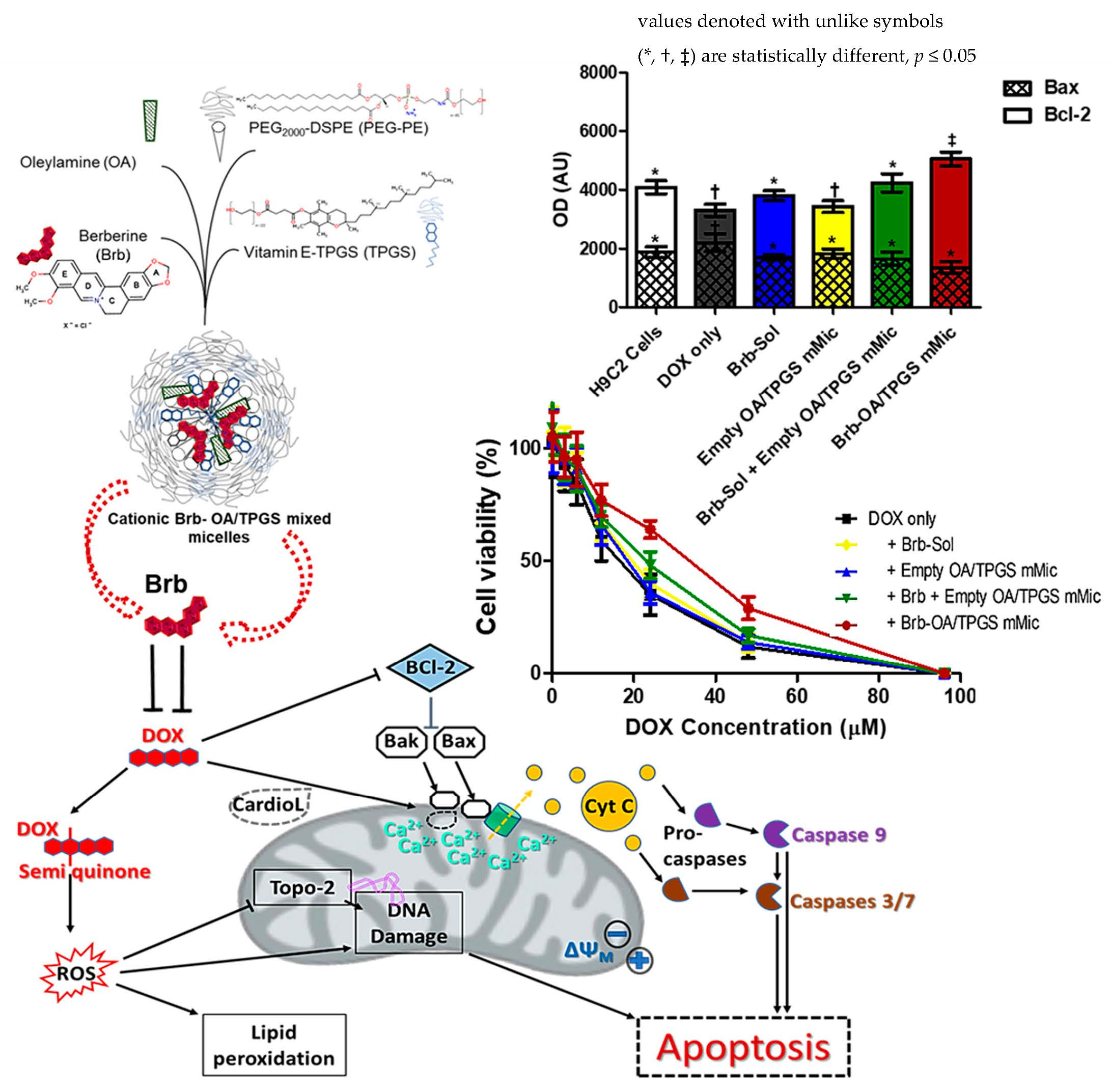Cationic Vitamin E-TPGS Mixed Micelles of Berberine to Neutralize Doxorubicin-Induced Cardiotoxicity via Amelioration of Mitochondrial Dysfunction and Impeding Apoptosis

Anthracycline antibiotics, namely, doxorubicin (DOX) and daunorubicin, are among the most widely used anticancer therapies, yet are notoriously associated with severe myocardial damage due to oxidative stress and mitochondrial damage. Studies have indicated the strong pharmacological properties of Berberine (Brb) alkaloid, predominantly mediated via mitochondrial functions and nuclear networks. Despite the recent emphasis on Brb in clinical cardioprotective studies, pharmaceutical limitations hamper its clinical use.
A nanoformulation for Brb was developed (mMic), incorporating a cationic lipid, oleylamine (OA), into the TPGS-mixed corona of PEGylated-phosphatidylethanolamine (PEG-PE) micelles. Cationic TPGS/PEG-PE mMic with superior Brb loading and stability markedly enhanced both intracellular and mitochondria-tropic Brb activities in cardiovascular muscle cells. Sub-lethal doses of Brb via cationic OA/TPGS mMic, as a DOX co-treatment, resulted in significant mitochondrial apoptosis suppression. In combination with an intense DOX challenge (up to ~50 µM), mitochondria-protective Brb-OA/TPGS mMic showed a significant 24 h recovery of cell viability (p ≤ 0.05–0.01).
Mechanistically, the significant relative reduction in apoptotic caspase-9 and elevation of antiapoptotic Bcl-2 seem to mediate the cardioprotective role of Brb-OA/TPGS mMic against DOX. Our report aims to demonstrate the great potential of cationic OA/TPGS-mMic to selectively enhance the protective mitohormetic effect of Brb to mitigate DOX cardiotoxicity.
Download the full article as PDF here: Cationic Vitamin E-TPGS Mixed Micelles of Berberine to Neutralize Doxorubicin-Induced Cardiotoxicity via Amelioration of Mitochondrial Dysfunction and Impeding Apoptosis
or read it here
Materials and Cell Lines
Berberine Hydrochloride (Brb HCl) and cationic oleyl amine lipid were purchased from Sigma-Aldrich (St. Louis, MO, USA). 1,2-Distearoyl-sn-glycero-3-phosphoethanolamine-N-[methoxy(polyethyleneglycol)-2000] (mPEG2000-DSPE or PEG-PE) and ovine wool cholesterol were purchased from Avanti Polar Lipids, Inc. (Alabaster, AL, USA) and used without further purification. Speziol® TPGS-Pharma (NF-grade Vitamin E polyethylene glycol succinate, TPGS) was received as a gift from Cognis (Cincinnati, OH, USA). All other reagents and components of buffer solutions were analytical-grade preparations. An orange mitochondrial membrane potential assay kit, colorimetric Caspase-8 and fluorometric Caspase-9 Assay Kits (microplate, Abcam, Cambridge, MA, USA), Trypsin/EDTA, penicillin/streptomycin, and fetal bovine serum were obtained from Fisher Scientific (Waltham, MA, USA), while the CellTiter Glo® 2.0 cell viability assay kit, Cytotox-ONE™ membrane integrity assay, and Orange Mitochondrial Membrane Potential Assay Kit (microplate) were purchased from Promega (Madison, WI, USA) and Abcam plc. (Cambridge, MA, USA), respectively. Both 6- and 12-well tissue culture-treated microplate plates and black 96-well tissue culture plates were purchased from BD-biosciences (San Jose, CA, USA). Rat Cardiomyocytes (H9C2), aortic medial smooth muscle cells (A10), and murine subcutaneous connective tissue fibroblasts (L929), along with Dulbecco’s Modified Eagle’s Medium (DMEM) and Eagle’s Medium (EMEM), were purchased from American Type Culture Collections (Manassas, VA, USA). Milli-Q (MQ) water was utilized for all preparations.
Metwally, A.A.; Ganguly, S.; Biomi, N.; Yao, M.; Elbayoumi, T. Cationic Vitamin E-TPGS Mixed Micelles of Berberine to Neutralize Doxorubicin-Induced Cardiotoxicity via Amelioration of Mitochondrial Dysfunction and Impeding Apoptosis. Molecules 2024, 29, 1155. https://doi.org/10.3390/molecules29051155
Watch the video below and read more on Vitamin E TPGS here:

